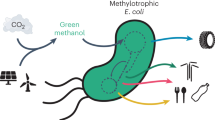Abstract
The most extremely thermophilic organisms known to date have been isolated from continental volcanic areas1–3, and grow optimally between 70 and 85 °C. In the hope of finding organisms living at temperatures above 100 °C I have taken samples from the hot sea floor of a submarine solfatara field where, as a result of the high pressures liquid water is found that is hotter than 100 °C. Here I report that, from these samples, I isolated unusual disk-shaped prokaryotic organisms, connected by a network of thin hyphae, which grew at 100 °C in the presence of sulphur, hydrogen and carbon dioxide. The organisms could be successfully transferred to synthetic media and were strict anaerobes, growing optimally at 105 °C and not at all at 80 °C or below. However, they did survive for long periods at 4 °C and −20 °C in the absence of oxygen. During growth, H2S was formed by sulphur reduction. Due to their extreme oxygen sensitivity, their unusual, irregular shape and primitive volcano-adapted metabolism, the novel organisms may represent a very ancient form of life existing in submarine volcanic areas in a water-supplied oxygen-free habitat, which has not changed for billions of years and which prevents competition with normal life due to prohibitively hot temperatures.
This is a preview of subscription content, access via your institution
Access options
Subscribe to this journal
Receive 51 print issues and online access
$199.00 per year
only $3.90 per issue
Buy this article
- Purchase on Springer Link
- Instant access to full article PDF
Prices may be subject to local taxes which are calculated during checkout
Similar content being viewed by others
References
Brock, T. D., Brock, K. M., Belley, R. T. & Weiss, R. L. Archs Microbiol. 84, 54–68 (1972).
Stetter, K. O. et al. Zbl. Bakt. Hyg., I. Abt. Orig. C 2, 166–178 (1981).
Zillig, W. et al. Zbl. Bakt. Hyg., I. Abt. Orig. C 2, 205–227 (1981).
Castenholz, R. W. in Strategies of Microbial Life in Extreme Environments (ed. Shilo, M.) 373–392 (Verlag Chemie, Weinheim, 1979).
Wildgruber, G. et al. Archs Microbiol. 132, 31–36 (1982).
Balch, W. E., Fox, G. E., Magrum, L. J., Woese, C. R. & Wolfe, R. S. Microbiol. Rev. 43, 260–296 (1979).
Zillig, W., Schnabel, R., Tu, J. & Stetter, K. O. Naturwissenschaften 69, 197–204 (1982).
Baross, J. A., Lilley, M. D. & Gordon, L. I. Nature 298, 366–368 (1982).
Heil, A. & Zillig, W. FEBS Lett. 11, 165–168 (1980).
Author information
Authors and Affiliations
Rights and permissions
About this article
Cite this article
Stetter, K. Ultrathin mycelia-forming organisms from submarine volcanic areas having an optimum growth temperature of 105 °C. Nature 300, 258–260 (1982). https://doi.org/10.1038/300258a0
Received:
Accepted:
Issue Date:
DOI: https://doi.org/10.1038/300258a0
This article is cited by
-
Bacterial diversity in 110 thermal hot springs of Indian Himalayan Region (IHR)
3 Biotech (2022)
-
Complete sequential assignment and secondary structure prediction of the cannulae forming protein CanA from the hyperthermophilic archaeon Pyrodictium abyssi
Biomolecular NMR Assignments (2020)
-
Oxidative stress protection and the repair response to hydrogen peroxide in the hyperthermophilic archaeon Pyrococcus furiosus and in related species
Archives of Microbiology (2010)
-
Stability of ribonuclease A under hydrothermal conditions in relation to the origin-of-life hypothesis: verification with the hydrothermal micro-flow reactor system
Research on Chemical Intermediates (2009)
Comments
By submitting a comment you agree to abide by our Terms and Community Guidelines. If you find something abusive or that does not comply with our terms or guidelines please flag it as inappropriate.



